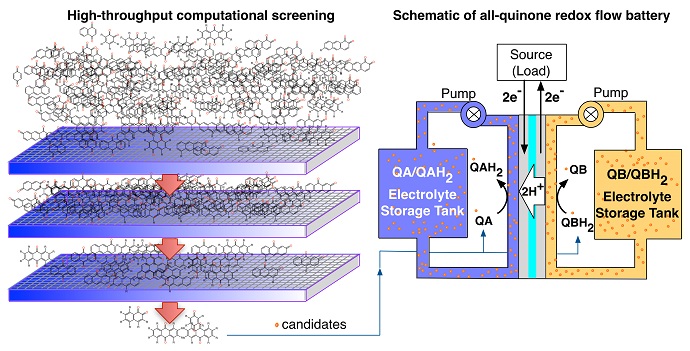December 9, 2014
Developing clean energy technologies, such as wind and solar, create new challenges to the grid as the electricity production from these sources is intermittent. Fundamental breakthroughs in electrical energy storage technologies are required to solve the mismatch between the increased electricity production from renewable energy sources, and the variable demand. Redox flow batteries are promising candidates for this purpose.
The design of flow batteries allows to store the reactants and the products outside the electrochemical conversion device, instead of within the battery container itself. This enables independent optimization of the device power and the stored energy. For an efficient flow battery, a suitable electroactive material with promising redox properties is a primary condition.
Quinones
Inspired by the electron transfer properties of quinones in biological systems, scientists recently reported on investigations of quinone redox couples based on the reversible protonation of molecules. The incorporation of earth-abundant and inexpensive quinone molecules into aqueous flow batteries is advantageous over current flow battery technologies in terms of scalability, kinetics, stability, solubility, and tunability. With the rising opportunity to use quinones for grid-scale energy storage, the primary challenge is to identify the best performing molecules that would meet the required properties and functionalities of a practical flow battery.
Virtual library of molecules
Given the huge number of organic molecules to be studied, FOM and Harvard researchers devised a large-scale computational study that is designed to screen the redox behaviors of molecules in an accelerated way. This will shorten the discovery time of new electroactive materials for flow batteries. Initially, a virtual candidate library of over 10,000 quinone/hydroquinone molecules was generated. This virtual chemicals library was continuously populated with new candidate molecules in close consultation with collaborating experimentalists from Aziz (Harvard School of Engineering and Applied Sciences) and Gordon (Chemistry and Chemical Biology) Groups of Harvard University.
Simulations
Next, computer simulations purely based on the fundamental rules of quantum physics were utilized to predict some of the key properties of candidate molecules, such as their three-dimensional structures, their solubilities and redox potentials in water. As new molecules were computationally studied, the scientists had an accumulated knowledge and an improved understanding of the important physical and chemical properties of quinones.
The sum of information on the key properties of virtual molecules made it possible to optimize the existing electroactive molecular materials. Furthermore, the emerging structure-property relationships opened a path to design many more molecules that can function as electroactive parts of flow batteries. The results show that about three hundred interesting quinone molecules may lead the way to the development of first-ever fully organic high-performance redox flow batteries. The performance of these top candidate molecules revealed in this study is expected to rival that of conventional flow battery technologies which have been progressively investigated since the early nineties.
Dr. Süleyman Er, first author of the research paper described the work: "The current study emphasizes the usefulness of materials screening approaches in exploring a large portion of molecular space in a reasonably short time. Our approach involves highly-accurate, large-scale electronic structure computations coupled with materials genomic models to create an accelerated opportunity to access the key properties of molecular materials."
Reference
'Computational design of molecules for an all-quinone redox flow battery', Süleyman Er, Changwon Suh, Michael P. Marshak and Alán Aspuru-Guzik, Chem. Sci., 2014, Published online on 21 November 2014, DOI: 10.1039/C4SC03030C.













